Test case : Two Tores
1. Introduction
In this page, I present the test case of Maxwell Quasi Static Problem in A-V Formulation with gauge condition for a geometry of two torus surrounded by air for instationnary case in Axisymmetrical case.
2. Run the calculation
The command line to run this case is :
mpirun -np 16 feelpp_toolbox_coefficientformpdes --config-file=mqs.cfg --cfpdes.gmsh.hsize=1e-3
3. Data Files
The case data files are available in Github here :
-
CFG file - Edit the file
-
JSON file - Edit the file
-
GEO file - Edit the file
4. Equation
We solve the A-V Formulation in axisymmetric and we assume that \(V\) is known.
With :
-
\(\Phi = r A_{\theta}\) : \(A_{\theta}\) component \(\theta\) of potential magnetic field
-
\(\sigma\) : electric conductivity \(S/m\)
-
\(\mu\) : electric permeability \(kg/A^2/S^2\)
-
\(U\) : tension \(Volt\)
5. Geometry
The geometry is two tores of conductor in cartesian coordinates \((x,y,z)\) or two rectangles in axisymmetric coordinates \((r,z)\), surrounded by air.
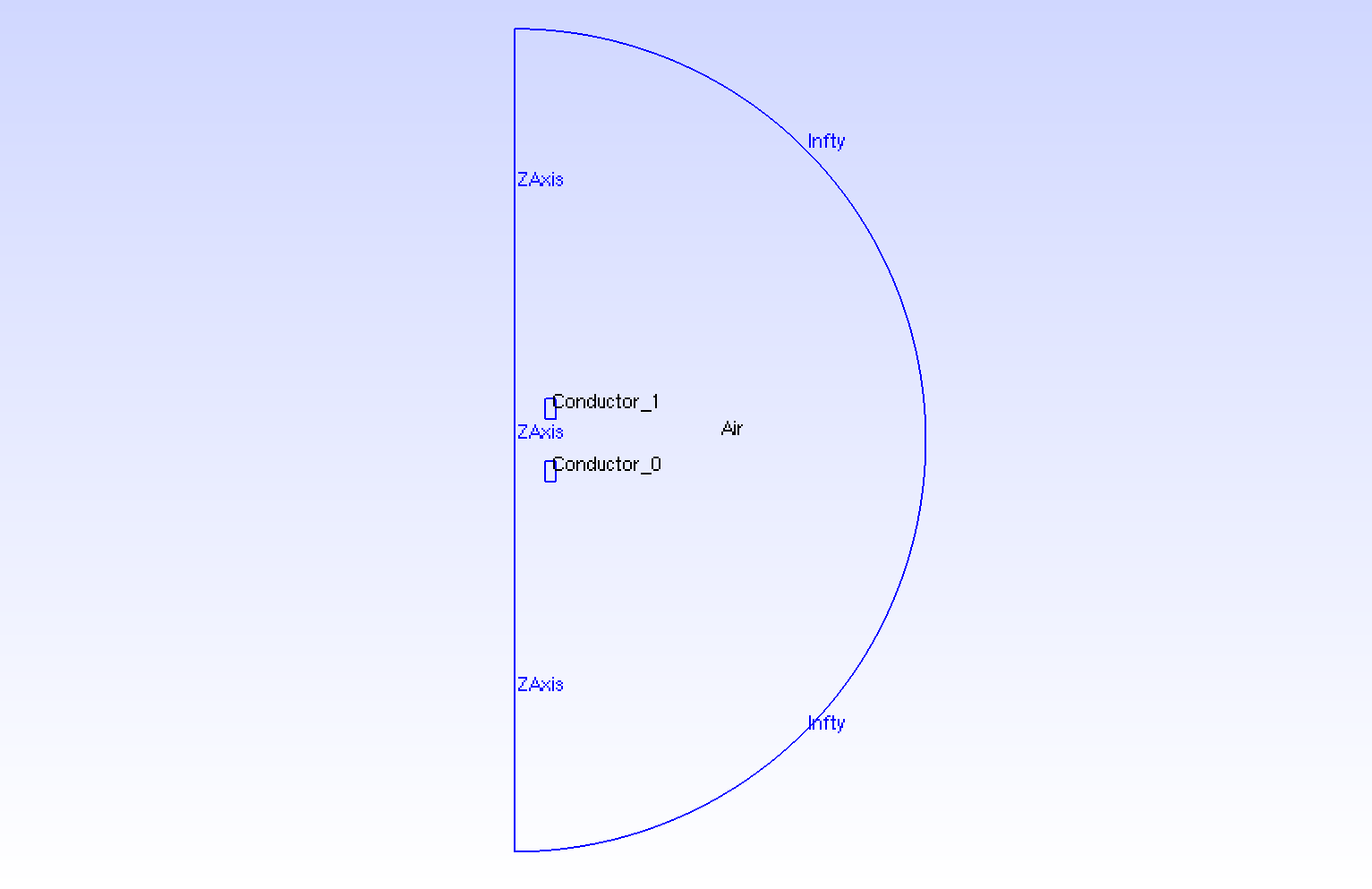
Geometry in Axisymmetrical cut
|
.png)
Geometry in Axisymmetrical cut loop on Conductors
|
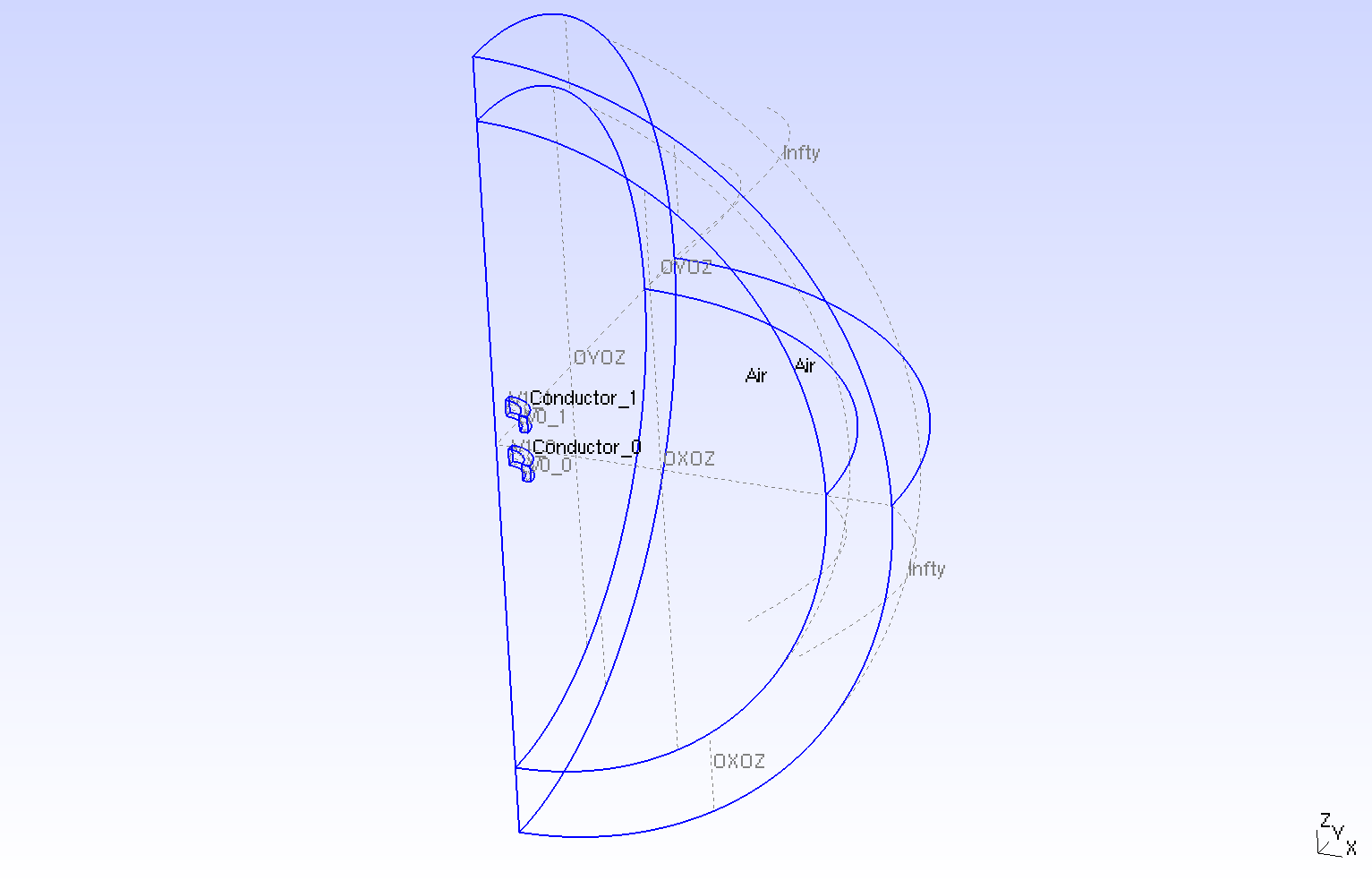
Geometry in three dimensions
|
.png)
Geometry in three dimensions loop on Conductors
|
The geometrical domains are :
-
Conductor_0: the torus is composed by conductor material -
Conductor_1: the torus is composed by conductor material
Conductor_0 \(\cup\) Conductor_1 \( = \Omega_c^{axis}\)
|
-
Air: the air surroundConductor_0andConductor_1-
zAxis: a bound ofAir, correspond to \(Oz\) axis (\(\{(z,r), \, z=0 \}\)) -
infty: the rest of bound ofAir
-
Air \(= \Omega^{axis} / \Omega_c^{axis}\).
|
Symbol |
Description |
value |
unit |
\(r_{int}\) |
interior radius of tores |
\(75e-3\) |
m |
\(r_{ext}\) |
exterior radius of tores |
\(100.2e-3\) |
m |
\(z_1\) |
half-height of tores |
\(25e-3\) |
m |
\(r_{infty}\) |
radius of infty border |
\(5*r_{ext}\) |
6. Initial/Boundary Conditions
We impose the Dirichlet boundary conditions :
-
On
zAxis: \(\Phi = 0\) (\(A_{\theta} = 0\) by symetric argument) -
On
infty: \(\Phi = 0\) (\(A_{\theta} = 0\) we consider the bound of resolution like infty for magnetic field)
We initialize :
-
On
Conductor_0andConductor_1: \(\Phi(t=0,r,z) = 0\) (\(A_{\theta}(t=0,r,z) = 0\)) -
On
Air: \(\Phi(t=0,r,z) = 0\) (\(A_{\theta}(t=0,r,z) = 0\))
On JSON file, the boundary conditions are writed :
"BoundaryConditions":
{
"magnetic":
{
"Dirichlet":
{
"ZAxis":
{
"expr":"0"
},
"Infty":
{
"expr":"0"
}
}
}
}
For initial condition, we write nothing in JSON, by default the application put zeros on initialization.
7. Weak Formulation
We obtain :
With \(\tilde{\nabla} = \begin{pmatrix} \frac{\partial}{\partial r} \\ \frac{\partial}{\partial z} \end{pmatrix}\)
8. Parameters
The parameters of problem are :
-
On
Conductor_0andConductor_1:
Symbol |
Description |
Value |
Unit |
\(V_0\) |
scalar electrical potential of |
\( U_0 \, \frac{\theta}{2\pi}\) |
\(Volt\) |
\(U_0\) |
electrical potential of |
\(\left\{ \begin{matrix} t/0.1 \text{ on } 0s \leq t \leq 0.1s \\ 1 \text{ on } 0.1s \leq t \leq 0.5s \\ 0 \text{ on } 0.5s \leq t \leq 1s \end{matrix} \right.\) |
\(Volt / rad\) |
\(V_1\) |
scalar electrical potential of |
\( U_1 \, \frac{\theta}{2\pi}\) |
\(Volt\) |
\(U_1\) |
electrical potential of |
\(\left\{ \begin{matrix} t/0.1 \text{ on } 0s \leq t \leq 0.1s \\ 1 \text{ on } 0.1s \leq t \leq 0.7s \\ 0 \text{ on } 0.7s \leq t \leq 1s \end{matrix} \right.\) |
\(Volt / rad\) |
\(\sigma\) |
electrical conductivity |
\(58e6\) |
\(S/m\) |
\(\mu=\mu_0\) |
magnetic permeability of vacuum |
\(4\pi.10^{-7}\) |
\(kg \, m / A^2 / S^2\) |
-
On
Air:
Symbol |
Description |
Value |
Unit |
\(\mu=\mu_0\) |
magnetic permeability of vacuum |
\(4\pi.10^{-7}\) |
\(kg \, m / A^2 / S^2\) |
9. Coefficient Form PDEs
We use the application Coefficient Form PDEs. The coefficient associate to Weak Formulation are :
-
On
Conductor_0andConductor_1:
Coefficient |
Description |
Expression |
\(d\) |
damping or mass coefficient |
\(\sigma\) |
\(c\) |
diffusion coefficient |
\(\frac{r}{\mu}\) |
\(\beta\) |
convection coefficient |
\(\begin{pmatrix} \frac{2}{\mu} \\ 0 \end{pmatrix}\) |
\(f\) |
source term |
\(- \sigma \frac{U_i}{2\pi} \, r\) with \(i=0,1\) |
-
On
Air:
Coefficient |
Description |
Expression |
\(c\) |
diffusion coefficient |
\(\frac{r}{\mu}\) |
\(\beta\) |
convection coefficient |
\(\begin{pmatrix} \frac{2}{\mu} \\ 0 \end{pmatrix}\) |
On JSON file, the coefficients are writed :
"Materials":
{
"Conductor_0":
{
"U":"t/(0.1)*(t<(0.1))+(t<(0.5))*(t>(0.1)):t", // Volt
"sigma":58e+6, // S.m-1
"mu":"4*pi*1e-7", // kg.m/A2/S2
"magnetic_c":"x/mu:x:mu",
"magnetic_beta":"{2/mu,0}:mu",
"magnetic_f":"-sigma*U/2/pi*x:sigma:U:x:mu",
"magnetic_d":"sigma*x:x:sigma"
},
"Conductor_1":
{
"U":"t/(0.1)*(t<(0.1))+(t<(0.7))*(t>(0.1)):t", // Volt
"sigma":58e+6, // S.m-1
"mu":"4*pi*1e-7", // kg.m/A2/S2
"magnetic_c":"x/mu:x:mu",
"magnetic_beta":"{2/mu,0}:mu",
"magnetic_f":"-sigma*U/2/pi*x:sigma:U:x:mu",
"magnetic_d":"sigma*x:x:sigma"
},
"Air":
{
"mu":"4*pi*1e-7", // kg.m/A2/s2
"magnetic_c":"x/mu:x:mu",
"magnetic_beta":"{2/mu,0}:mu"
}
}
10. Numeric Parameters
-
Time
-
Initial Time : \(0s\)
-
Final Time : \(1s\)
-
Time Step : \(0.005s\)
-
-
Mesh size :
-
Interior of torus : \(0.001 m\)
-
Far of torus : \(0.004 m\)
-
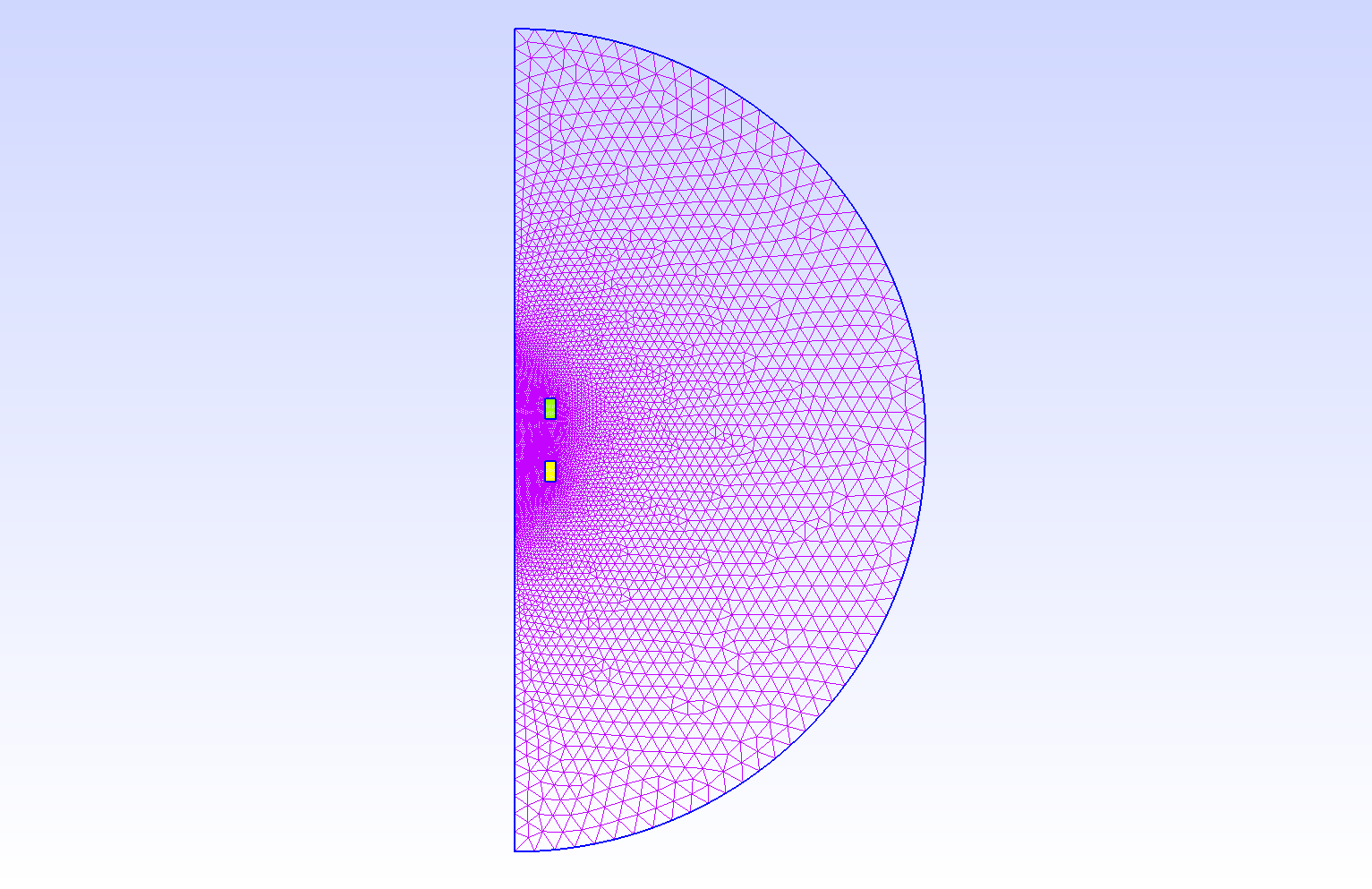
Mesh of Geometry
|
12. Exact Solutions
12.1. Intensity
In this subsection, we see the analytical compute of intensities.
We have :
With \(I_0\) the intensity of Conductor_0 and \(I_1\) the intensity of Conductor_1. \(R\) is the resistance of two tores, \(L\) the inductance of two tores and \(M\) the mutual inductance between the two tores.
And :
To solve this system of equation, we pass in vectorial formulation, we pose \(\mathbf{I} = \begin{pmatrix} I_0 \\ I_1 \end{pmatrix}\), \(\mathbf{U} = \begin{pmatrix} U_0 \\ U_1 \end{pmatrix}\), \(\mathbf{R} = \begin{pmatrix} R & 0 \\ 0 & R \end{pmatrix}\) and \(\mathbf{L} = \begin{pmatrix} L & M \\ M & L \end{pmatrix}\). The (I 2torus) equation becomes :
| \(\mathbf{R}\) and \(\mathbf{L}\) are supposed invertible. |
-
Resolution of First Part \((0s\leq t \leq 0.1s)\) :
The harmonic equation \(\mathbf{R} \, \mathbf{\tilde{I}} + \mathbf{L} \, \frac{d \mathbf{\tilde{I}}}{d t} = 0\) have a solution \(\mathbf{\tilde{I}} = e^{-\mathbf{R}\mathbf{L}^{-1} \, t}\)
We pose \(\mathbf{I} = e^{- \mathbf{R} \mathbf{L}^{-1} \, t} \, \mathbf{C}\), with \(\mathbf{C}(t) \in \mathbb{R}^2\) such as \(\mathbf{I}\) verify (I 2torus) (we consider that \(\mathbf{I}(0)=0\) thus \(\mathbf{C}(0)=0\) ) :
Thus :
Recall : \(e^{\mathbf{A}}\) commutes with \(\mathbf{A}\), thus :
-
Resolution of three last part (\(0s\leq t \leq 0.1s\), \(0.1s\leq t \leq 0.5s\) and \(0.5s\leq t \leq 1s\)) :
We have :
With \(\mathbf{U}\) constant (\(U = \begin{pmatrix} 1 \\ 1 \end{pmatrix}\), \(\begin{pmatrix} 0 \\ 1 \end{pmatrix}\) and \(\begin{pmatrix} 0 \\ 0 \end{pmatrix}\))
The solution of this equation is :
Conclusion : the solution of the equation (I 2torus) is :
With \(\mathbf{C}_1\), \(\mathbf{C}_2\) and \(\mathbf{C}_3\) constants which assure the continuity of intensity.
13. Results
13.1. Magnetic Fields
I plot the horizontal magnetic field by time on point \((0,0,0)\).
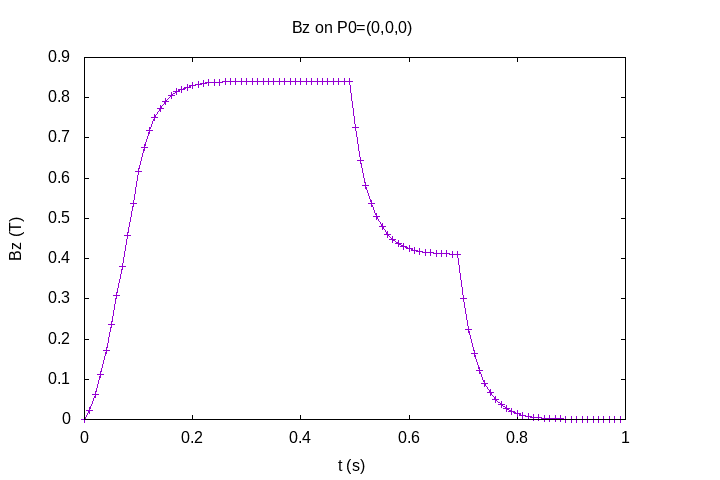
Horizontal Magnetic Field \(B_z (T)\) by time
|
We can see the four step :
-
the ramp for the two tensions
-
the tray for the two tensions
-
the tray for the tension \(U_1\) and the tray at 0 for the tension \(U_0\)
-
the tray for the tray at 0 for the tensions \(U_0\) and \(U_1\)
13.2. Intensities
The analytical solve of intensities is computed by python3’s script : Edit the file, with the formula :
And the values :
Symbol |
Description |
Value |
Unit |
\(R_0\) |
resistance of |
\(7.479339e-06\) |
\(Ohm\) |
\(R_1\) |
resistance of |
\(7.479339e-06\) |
\(Ohm\) |
\(L_0\) |
auto-inductance of |
\(1.920400e-07\) |
\(Henry\) |
\(L_0\) |
auto-inductance of |
\(1.920400e-07\) |
\(Henry\) |
\(M_{01}\) |
inductance from |
\(1.705000e-08\) |
\(Henry\) |
\(M_{10}\) |
inductance from |
\(1.705000e-08\) |

Intensities : Comparison between numerical and analytical results
|
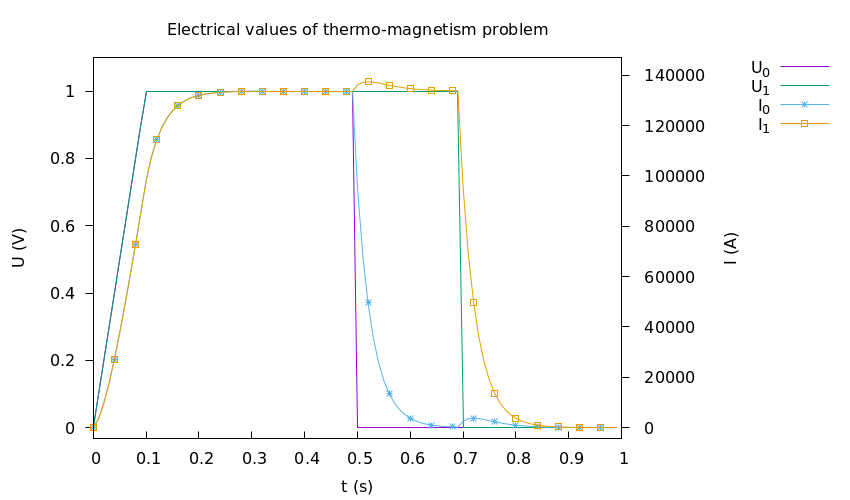
Figure 1. Intensities \(I_i (A)\) and Tensions \(U_i(V)\), caption=
|
The intensities follow the tensions like for 1-Torus problem with the four step (ramp, trays and cuts). But, we can see little peaks. This peak on one intensity appears when the tension of other conductor is cut. This phenomena is called Electromagnetism Induction.
The Electromagnetism Induction is the production of an electromotive force across an electrical conductor in a changing magnetic field.
With the equation of Maxwell-Faraday :
We can see, with time variation of magnetic field \(\mathbf{B}\), we have creation of electrical field. For us case, when we cut the tension for one conductor, we have great time variation of magnetic field thus the other conductor answer by Maxwell-Faraday equation with creation of electrical field and current. When the magnetic field is at zeros, is phenomena disapears.